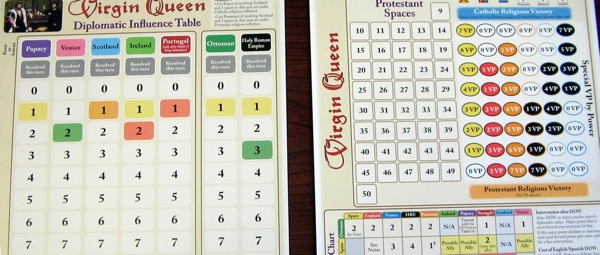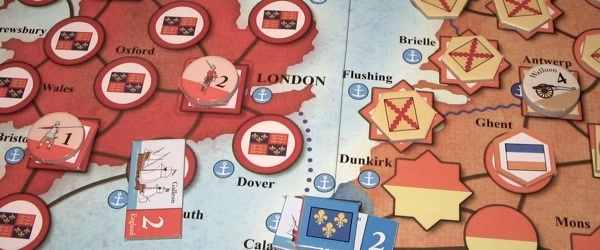Virgin Queen – Boardgame Review
 Virgin Queen: Wars of Religion 1559–1598. Board Game. Publisher: GMT Games Designer: Ed Beach. $89
Virgin Queen: Wars of Religion 1559–1598. Board Game. Publisher: GMT Games Designer: Ed Beach. $89
Passed Inspection: Big, expansive game with a wonderful mounted map. Tons of historical options—war, politics, religion, piracy, everything is right there in the rules.
Failed Basic: Rules need an index and more clarifications. Not an easy-to -earn game. No solitaire playability. Set aside 4 to 8 hours to play this one.
From 1559 to 1598, Europe was aflame with political and religious strife. The Lutheran challenge to the Catholic Oligarchy had resulted in two competing religious systems— often leading to violence and repression. The German states were allowed to choose between the two competing religions. England and The Netherlands were ruled by Protestant friendly rulers. Spain and France were firmly allied with the Catholic Church. The Holy Roman Empire and the Ottomans under Suleiman the First played both sides in order to expand their influence.
{default}This turbulent time period is the backdrop for GMT’s new game Virgin Queen: Wars of Religion 1559-1598. The designer of the game, Ed Beach, created this game to be a sequel to his 2006 Here I Stand. While the first game represented the growth of the Lutheran movement in Europe, this sequel shows Protestantism in full swing and the associated conflicts between it and the Catholic Church. While the game does not wholly focus on religious strife, the tension is definitely in the background waiting to lead to full-scale war. You do not have to have the first game in order to play Virgin Queen.
In Virgin Queen, each player takes a power from that time period. England, France, Spain, the Ottoman Turks, the Holy Roman Empire, and the Dutch/Huguenots are all available. Minor powers are also included for negotiations, trading, invasion, etc.

The map is a beautiful work of art representing the European view of the world circa 1550—it is fully mounted and, actually, could be hung on a wall as artwork. Die-cut counters represent leaders, armies (both national armies and mercenaries), ships, area political and religious affiliations, fortifications, and other important data providing all the players could want to know about the current turn at a glance. Varieties of tables display combat results, political influences and even royal marriages! A Scenario Book is included which contains designer’s notes, a look at the history the game simulates and, of course, a variety of scenarios.
Set up can take an hour or more depending on the scenario chosen. The game is only multi-player. There are no considerations or scenarios for solitaire play. Player set up provides rules to accommodate from two to six players.
Each turn represents five to six years and each turn is broken in to the following phases: Card Draw Phase, Diplomacy Phase, Spring Deployment Phase, Action Phase, Winter Phase, Marriage Resolution Phase, Patronage Phase and the Victory Determination Phase.
Cards are used to provide random events which are either mandatory to play or may be used by the players to help themselves or their allies or hurt the other players. Card results include such noteworthy events as Treachery (which hurts players trying to defend during a siege), the Grand Tour (which allows the French player to eliminate religious unrest from his country), Scottish Lords Rebel (religious and political strife), Untimely Death (eliminates a leader from the game), and many others. Some cards can only be played after a specific turn number in the game while others apply from Turn 1 on.

Even the charts are attractive.
During the Diplomacy Phase, players are encouraged to make and break alliances, propose marriages, trade, ransom captured leaders, declare war, etc. This player-to-player interaction is the key to the game and is why it would be very difficult to play solitaire. I believe, however, that should some designer want to try his or her hand at it a solitaire system could be developed using random actions and an action/re-action table, but as of this date, no one has tackled the challenge.
During the Spring Deployment Phase, each side can place new leaders on the board, move some troops, place escorts for fleets heading towards the new world, etc.
The Action Phase is where it all happens! In this phase, armies move and fight, sieges occur, ships move, explore, conduct pirate raids, and other mayhem can occur.
During the Winter Phase, things begin to reset and the craziness of the Action Phase begins to break. Units return to fortified positions, unrest can begin to creep into territories, etc.

The three other phases track royal marriages (which can be just as important as military actions to winning the game); encourage artists and scientists in their endeavors; and the turns ends with an assessment of where every player stands in terms of Victory Points. Each country has its own set of objectives for winning the game. Some, such as Spain, may depend on a powerful navy to spread its influence through conquest and exploration and even founding colonies in the New World, while others, such as the Dutch, can spread religious unrest.
It is the sheer number of options for strategies that make the game so immersive and fascinating, but they also add to the new player’s frustration with the rather steep learning curve.
The rules are very complete and well laid out with plenty of examples, but some specific sections are not very clear and an index would have been great help in locating a rules section when needed. (Why is it that far too many game companies don’t seem to understand the need for a complete index of the rules?) It also seems that for every rule, there are several exceptions, which adds to the frustration of learning this game.

Example of a country’s card
In our review sessions, we had four players. All were experienced gamers with at least 10 years gaming experience (some as high as 35 years) and we even had an attorney in the group. Unfortunately, none of us had played Here I Stand, so we were not that familiar with the rules. It took us over three hours to complete Turn 1, even with skipping the Marriage and Patronage Phases. Three of the players had read the rules at least once, but we ended up page-flipping more than playing in order to figure out how take some specific actions. There is a two-player tutorial provided, but a beginner’s solitaire pre-programmed scenario would help ramp players up to speed.
While the game is a first-class effort and all the players in my group want to work with it more to learn the rules, the steep learning curve and lengthy game play may limit the players who would give this game a chance. But as it is Virgin Queen is an exciting and innovative game covering an underexposed time period. Learning to play it is worth the effort if you can spare the time.
Armchair General Rating: 87%
Solitaire Rating: 1 out of 5 (1 is virtually unplayable solitaire)
About the Author
A college film instructor and small business owner, Richard Martin has also worked in the legal and real estate professions, is involved in video production, film criticism, sports shooting and is an avid World War I and II gamer who can remember war games which came in plastic bags and cost $2.99 (he’s really that old)!


Rick, good review thanks, but I would take issue with the solitaire playability score. Many of us play it solitaire successfully and it is great fun. It’s a fair representation of history so the major strategic decisions take care of themselves.
Please let me know how you play it solitaire because I would love to do that. It’s so hard to get a group together to play it. Thanks in advance!
I’ve played Virgin Queen solitaire three times. Essentially, I just play all of the powers, make up deals and wars, and pretend not to know what all the other powers are planning when I play a card for one. The mechanics, the drama of the dice, and the historical references on the cards make it very interesting. For whatever reason, the Protestants have won twice and the Ottomans once.